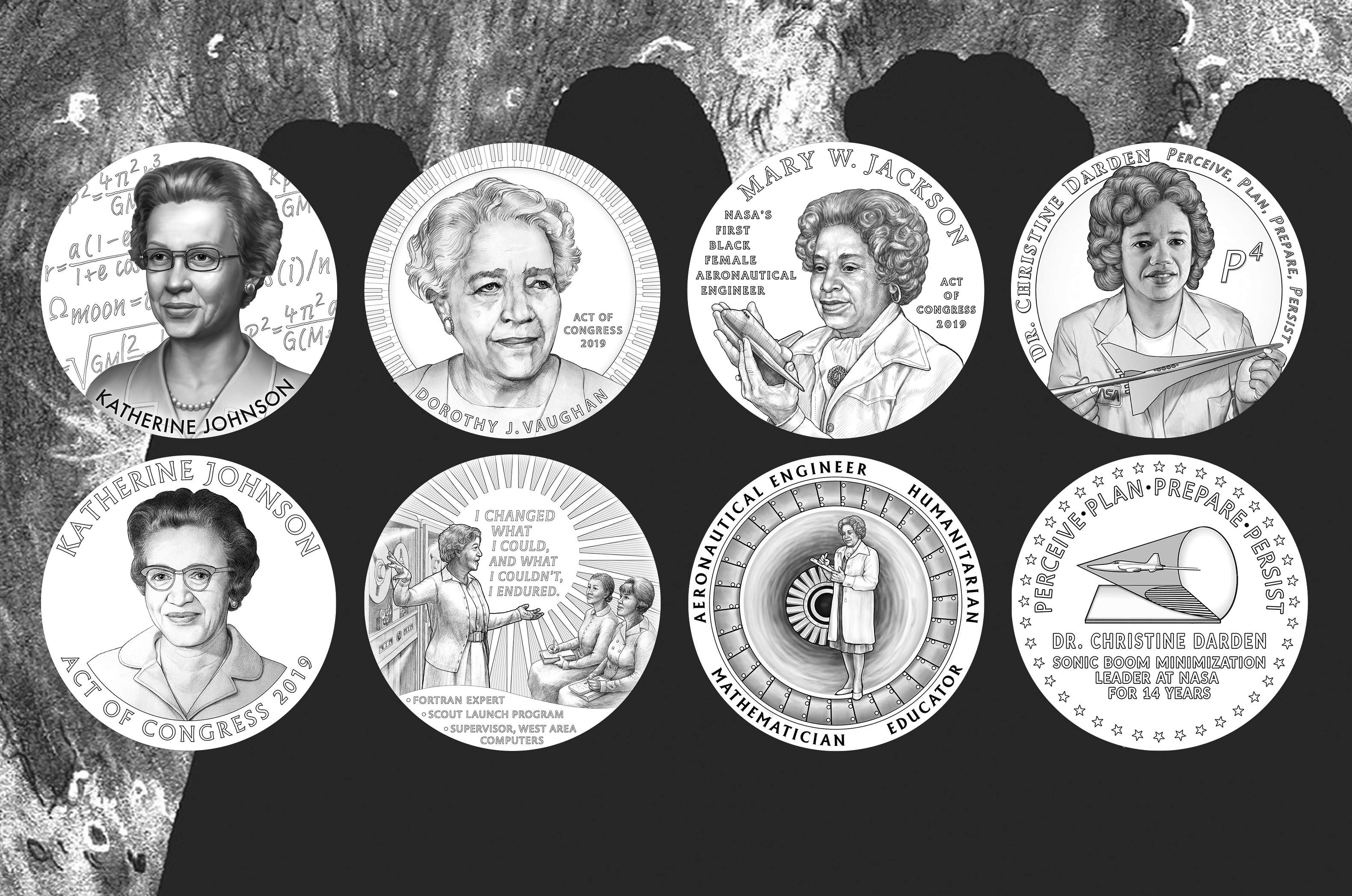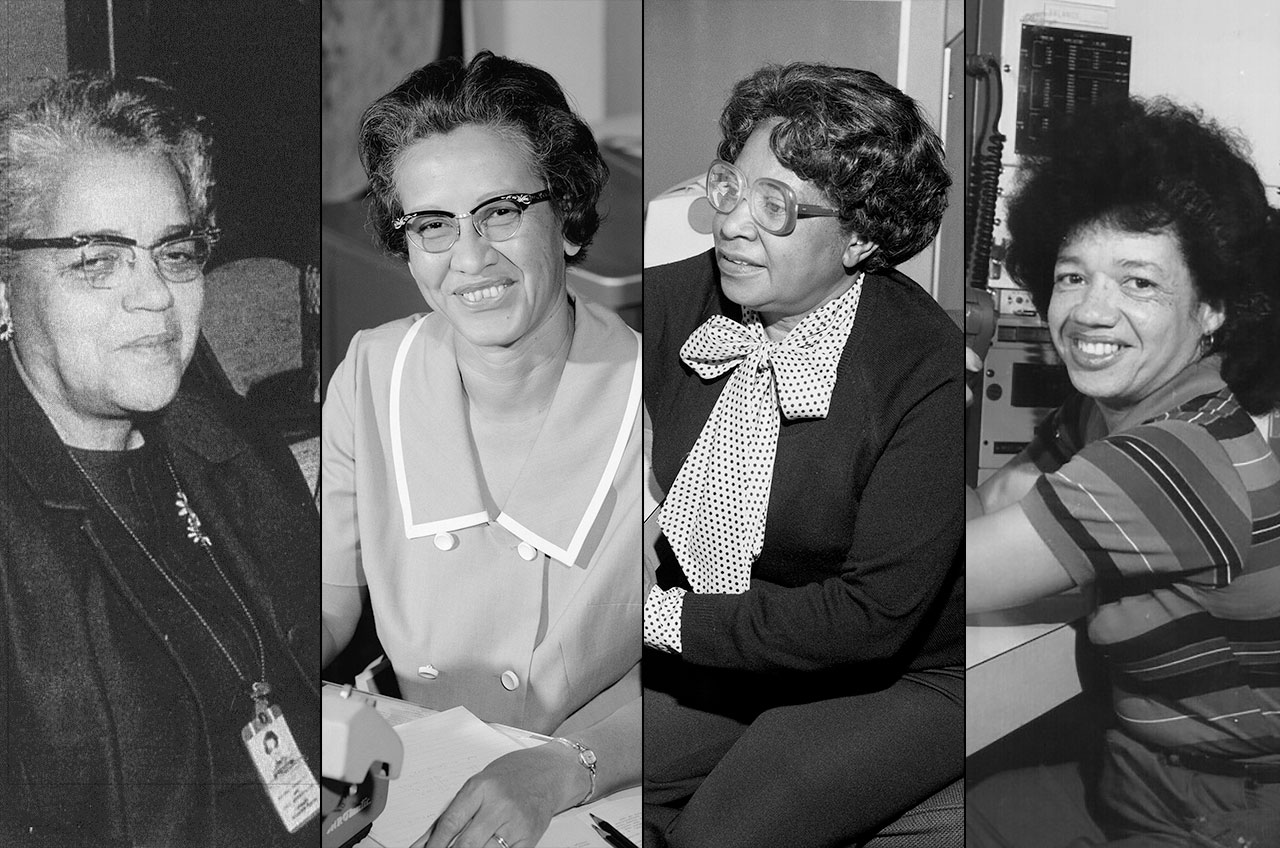Panel reviews designs for NASA's 'Hidden Figures' Congressional Gold Medals

When it comes to depicting the women mathematicians and engineers whose work helped to advance supersonic flight research and landing the first humans on the moon, do you show them as "hidden figures" or do you bring them into the light?
That was the primary question raised by a panel charged with reviewing the U.S. Mint's designs for the Hidden Figures Group Congressional Gold Medal, one of five such awards intended to recognize four specific women and the hundreds of others who served the National Advisory Committee for Aeronautics (NACA) and NASA from the 1930s through the 1970s.
"The title 'Hidden Figures' is a reference to the book by Margot Lee Shetterly and the film released in 2016 of the same name, and it has a double meaning," April Stafford, director of the U.S. Mint's Office of Design Management, said at a Sept. 23 meeting of the Citizens Coinage Advisory Committee (CACC). "It refers to the mathematical calculations that went into the work at NACA and NASA, but also to the women who worked behind the scenes performing these calculations."
Related: NASA's real 'Hidden Figures'
The CACC concluded its review of all five Hidden Figures gold medals, including designs honoring mathematician Katherine Johnson, manager Dorothy Vaughan and engineers Mary Jackson and Christine Darden, during a second meeting on Nov. 17.
For the group medal, the 11-person committee reviewed eight concept designs created by U.S. Mint artists and recommended an obverse (or head's side) "showing a group of silhouetted women looking on as the historic Apollo 11 mission successfully put the first men on the moon," according to chairman Thomas Uram.
"The figures are symbolic of the 'hidden' nature of the many women, including many women of color, who served as computers, mathematicians and engineers with NASA and NACA," Uram wrote in a letter to the Secretary of the Treasury.
Get the Space.com Newsletter
Breaking space news, the latest updates on rocket launches, skywatching events and more!

The recommended reverse (or tail's side) features the constellation Andromeda, the "chained woman" in Greek mythology, as a symbol of "the obstacles and difficulties overcome by the women whose contributions to space and aeronautics are finally being recognized and celebrated," explained Uram.
The recommended designs were preferred by many of the committee's members, in part for their artistic quality, but it was not unanimous. At issue was whether the "Hidden Figures" women should be depicted in silhouette or in full light.
"These are very important, very critical human beings and they are ignored. They are invisible. They are blacked out. And they've been blacked out for 50 years," said committee member Donald Scarinci, who owns one of the largest collections of art medals in the United States. "So I think nothing says that more — I mean, you can't get something more expressive and more emotive than [this obverse]."
Dennis Tucker, a numismatic researcher and writer, had an opposite reaction to the same design.
"I found the ones that use silhouette to keep the women in the background, in the shadows, I found those to be almost offensive, backward looking," said Tucker. "This tells the story of how they were kept down, rather than how the advances that they made and the service that they performed for our nation."
"I have to admit," said Peter van Alfen, chief curator for the American Numismatic Society, "that initially I was a little conflicted by the silhouette ... by the sense of keeping these women still in the shadows. But, I think that conflict was basically overwritten by the fact this really would be an amazingly just impressive medal."
Mary Lannin, a former public television producer and director who rekindled her childhood love for coin collecting, championed the silhouette design.
"[Those] who were worried about keeping the figures hidden, still in the shadows — you know what, that's everyone. We all are hidden like that when we're gazing at the moon," Lannin said.

The Mint worked with members of NASA's history program office, including acting chief historian Brian Odom, to review the proposed designs for technical accuracy and appropriateness. The space agency differed in its own choices, preferring obverses that showed fully-lit, representative faces and reverses that depicted the projects that the women worked on, including a Mercury capsule, an experimental aircraft and an Atlas rocket.
The NASA representatives who were consulted served as subject matter experts. The CACC tended to put more weight on the preferences of the family members, or in the case of Darden, the honoree herself, when making recommendations for the personal medals:
- The committee recommended designs for the Congressional Gold Medal honoring Johnson, who died in February at the age of 101, that featured a portrait of the young "computer" backdropped by math equations on the obverse and a forward-facing portrait of an older Johnson on the reverse.
- For Vaughan, the committee recommended an obverse showing a portrait of the mathematician with an upward gaze, surrounded by a piano key border symbolizing her love of music. For the reverse, the CACC agreed with the preference of Vaughan's family, a design depicting her in her role as the supervisor of the West Area Computers at the Langley Research Center, with the inscription, "I changed what I could, and what I couldn't, I endured." Vaughan died in 2008 at the age of 98.
- Again siding with family members, the committee's choices for the Mary Jackson Congressional Gold Medal featured NASA's first Black female aeronautical engineer holding an early model of the space shuttle on the obverse and on the reverse, a full-length portrait of Jackson standing in front of large wind tunnel, representing her work studying the behavior of the boundary layer of air around airplanes. Jackson died in 2005 at 83.
- The CACC had the rare opportunity to hear directly from an honoree in the case of Darden, 78, who retired from NASA in 2007 after a 40-year career in aerodynamics. The recommended designs highlight Darden's work on minimizing the effects of sonic booms by depicting her holding a model of a supersonic aircraft on the obverse and showing a different model in a wind tunnel on the reverse. The committee suggested changing an inscription on the tail side from "Perceive, Plan, Prepare and Persist" to "Act of Congress 2019," to be consistent with the other four medals.
The Secretary of the Treasury will consider the CACC's recommendations, along with the results of a similar review by the Commission of Fine Arts, when deciding on the final designs for the five Hidden Figures Congressional Gold Medals. In addition to striking the gold medals that will be presented to the honorees, the U.S. Mint will also produce duplicates in bronze to be sold to the public in 2021.
The Congressional Gold Medal is awarded to individuals whose accomplishments have had an impact on U.S. history that is likely to be recognized in the recipient's field for years to come. First bestowed to George Washington in 1776, only five other people who contributed to the country's space exploration efforts have been awarded the Congressional Gold Medal to date: rocket pioneer Robert Goddard in 1959 and astronauts John Glenn, Neil Armstrong, Buzz Aldrin and Michael Collins in 2011.
Click through to collectSPACE to see the 59 other designs that U.S. Mint artists created for the Hidden Figures Congressional Gold Medals.
Follow collectSPACE.com on Facebook and on Twitter at @collectSPACE. Copyright 2020 collectSPACE.com. All rights reserved.
Join our Space Forums to keep talking space on the latest missions, night sky and more! And if you have a news tip, correction or comment, let us know at: community@space.com.

Robert Pearlman is a space historian, journalist and the founder and editor of collectSPACE.com, a daily news publication and community devoted to space history with a particular focus on how and where space exploration intersects with pop culture. Pearlman is also a contributing writer for Space.com and co-author of "Space Stations: The Art, Science, and Reality of Working in Space” published by Smithsonian Books in 2018.In 2009, he was inducted into the U.S. Space Camp Hall of Fame in Huntsville, Alabama. In 2021, he was honored by the American Astronautical Society with the Ordway Award for Sustained Excellence in Spaceflight History. In 2023, the National Space Club Florida Committee recognized Pearlman with the Kolcum News and Communications Award for excellence in telling the space story along the Space Coast and throughout the world.










